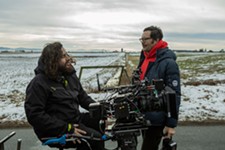Can AISD Enable "Equity"?
School board makes another attempt to define and create equitable schools
By Richard Whittaker, Fri., April 10, 2015
"Equity" is the current buzzword in education. It drove the 2014 Austin Independent School District board elections, as voters and candidates pondered how to give kids from poor homes, English language learners, and kids in special education programs the same options and opportunities as middle-class high achievers. But like "affordability" in the City Council races, overuse made the term nearly meaningless. As AISD is planning a study into equity issues across the district, board members are still defining their goal.
First, a clarification. The board has not begun an equity study; on March 30, AISD trustees voted to adopt a "framework" to develop the terms, processes, and protocols for an equity study. Now that framework passes responsibility to the newly minted AISD Board Oversight Committee on Excellence Through Equity, Diversity, and Inclusion. Consisting of four board members – plan creators Ted Gordon and Paul Saldaña, board Secretary Jayme Mathias, and At-Large Trustee Kendall Pace – the committee's job is to work out the next step. Saldaña's initial goal for the final study may seem minimal. He said, "I would be happy with statements that come with quantifiable data ... for me, that's enough." However, consider the headline background: an increase in Title I schools (those receiving federal aid for at-risk and low-income students) from 50 schools in 2000 to 77 now, and from 35% of all students to 50%. As time goes on, he said, "We're going to be left with just serving poor kids. We're losing our middle-class students."
Education Austin President Ken Zarifis applauded the step, saying, "I think equity is a good thing, so I think studying equity is a very good thing." While the roots of the discussion and its issues are decades old, Zarifis called it timely for "a district and a city that's grappling with who we are."
A key driver behind this move was a 2012 report by the Texas Civil Rights Project (see "Report Highlights Inequities in AISD Funding," Sept. 21, 2012) that criticized the district for the way it allocated funds to campuses. A 2014 follow-up doubled down on endowments and parental volunteerism that again benefit wealthier neighborhoods, calling on the district to rebalance that equation through the creation of a district-wide foundation. Report author and TCRP staff attorney Abby Frank commended the board's study proposal, saying, "We're thrilled that it had broad support on the board, which we think reflects broad support in the community."
However, there is still much work to be done before any real study can begin. Saldaña wants the self-assessment to commence in June. Pace suggests it could take months of public consultation to fill out the framework. Then there is the big question: What does equity mean? Nowhere in the board discussions is there a precise definition. It will be the job of the new board committee to define "equity" – or, possibly, to establish a citizens' body to rough out a definition the board can finalize. That has to be accomplished before the actual study can be done.
That's deeply concerning for Pace, who fears the board is losing control of the process. "You already see the posturing beginning," she said, noting that special interest groups are filling the void with their own conceptions – ones that will generally benefit them. She said, "If you don't choose their definition, then we're going to disappoint them."
So what is equity? For TCRP attorney Frank, it means "equity in programs, equity in level of teacher experience." She suggested the district look to the U.S. Department of Education's Office for Civil Rights for guidance. However, she warned, "We can talk about definitions all day, but that just gets us off-track."
Since so much of the discussion will come around to money, Zarifis argues that the first step must be separating out equity from equality. He said, "I compare it to the cartoon of three people of varying heights looking over a fence at a baseball game: The tall one can look over the fence, the middle one can just see over, and the shortest one can't see over." Equality is giving everyone the same size box to stand on, whether it helps or not; equity is about ensuring everyone can see over the fence. That may seem optimistic, but he said, "our definition of equity has to be aspirational. It has to be that the kids who enter the system behind have the resources to leave the system equal with the kids who entered the system ahead."
Saldaña says the study isn't about finger-pointing, and can actually be a selling point. He has already received a list of 25 programs from Superintendent Paul Cruz that are having measurable impacts on campus achievement, and that could be readily implemented elsewhere. Saldaña said, "We need to shift from being on the defense all the time."
Saldaña is also optimistic about creating a definition for equity, noting that the district paid for a two-year study in 2007 that can be used as a base for discussion. But before the process goes too far, Pace thinks the board should offer "at least some operating parameters," if only to end wilder speculation. She said, "People think they're going to get more money, some people are afraid they're going to get less money, people think there's going to be another bond. I'm hearing all of these."
Her fear is that the district is setting off, not just without a clear destination, but without a functioning compass. Her concerns are two-fold. First, that this becomes another nebulous study that gets ignored. ("The district came out two years ago and said we under-invest in our elementaries," she said, "but we buried that.") Second, that this becomes a rerun of the 2011 Facility Master Plan debacle (see "What the Task Force Wrought," May 27, 2011), or the ongoing free-for-all about the new South high school, where a lack of clarity from the board has let speculation run riot. "The more we talk about it in these sweeping generalizations," Pace said, "the more disappointing it will be."
Got something to say on the subject? Send a letter to the editor.












